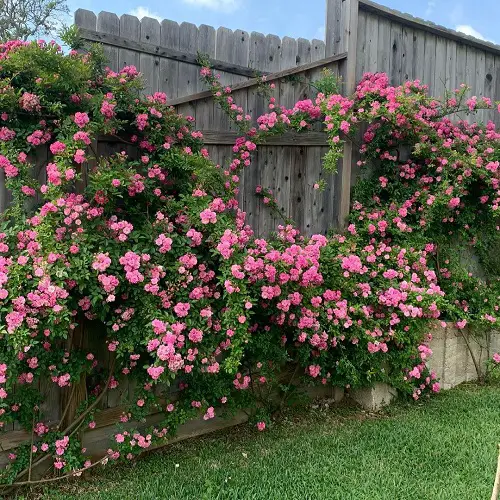Here’s everything you need to know about the beautiful Peggy Martin Climbing Rose Care and Growing Information!

The Peggy Martin Climbing Rose is a gorgeous and hardy plant that blooms profusely in pink from spring through fall. It is also easy to maintain, even for beginners!
Peggy Martin Climbing Rose Information

Peggy Martin Climbing Rose is popularly known as the “Hurricane Katrina Rose.” It is named Peggy Martin as it was discovered by a girl named Peggy Martin after the devastating storm called “Hurricane Katrina.”
The most intriguing feature of the Peggy Martin Climbing Rose is the fact that it can survive in a variety of conditions, including hot, humid summers and cold, harsh winters. The rose is drought-tolerant and can thrive in a wide range of soils, from sandy loams to heavy clays. This unique feature of Peggy Martin made it the sole surviving plant of Hurricane Katrina’s destructive winds and floods.
Peggy Martin Climbing Rose roses can reach from 6 feet to 15 feet easily and are even taller, making them an excellent choice for covering fences, walls, trellises, and arbors. The plant is also known for its exceptional disease resistance, withstanding pests and diseases that commonly plague other roses.
The rose features large, pink, double blooms that are borne in clusters. The flowers have a delicate, sweet fragrance and are often described as being reminiscent of old-fashioned roses. The rose blooms continuously throughout the growing season, from late spring to fall, providing a continuous display of color and fragrance.
Fact: This rose was propagated by Peggy Martin, who shared the rose with other gardeners, which led to its widespread popularity.
Propagating Peggy Martin Climbing Rose
- Take a 6-to-8-inch-long cutting from the current season’s growth.
- Remember to cut the stem at an angle just below a leaf node.
- Now, remove lower leaves and apply either a rooting hormone or cinnamon dust to improve rooting success.
- Make holes in the prepared potting mix using a stick.
- Place the cutting into the holes, firm the soil around it, and water the surface.
- It takes around 5 to 10 weeks for roses to root – after which you can re-pot it in a larger pot or outdoors.
Check 9 Cool Ways to Propagate Roses From Cuttings
Requirements for Growing Peggy Martin Climbing Rose

Location
It will bloom best if it receives at least six hours of sunlight per day. Remember to avoid areas where sunlight may be blocked by tall trees or other structures that provide shade.
Soil
Peggy Martin Climbing Rose prefers well-draining, fertile soil with a pH between 6.0 and 6.5. To improve the soil, add compost, aged manure, or leaf mold. For best results, mix these amendments into the soil to a depth of at least 12-16 inches.
It is important to make sure the soil is well-aerated, as roses need air to their roots. If the soil is compacted, use a garden fork or tiller to loosen the soil before planting.
Watering
Water Peggy Martin Climbing Rose early in the morning or late in the afternoon to reduce evaporation. Avoid watering the leaves, as this can lead to fungal diseases.
Water until the soil around the base of the bush is saturated, and allow the soil to dry out slightly between waterings.
In the winter, water roses less often. Once a month should be sufficient in mild climates.
Find How to Grow Most Fragrant Roses
Peggy Martin Climbing Rose Care

Fertilizing
Fertilize the plant using a balanced liquid feed like 10-10-10 every 5-6 weeks after diluting it to 1/2 of its strength.
Also, ensure you always fertilize your roses when new growth appears in the spring. Be sure to water your roses after fertilizing to help the fertilizer reach the roots.
Stop fertilizing your roses in the fall when new growth slows down.
Pruning
Prune Peggy Martin Climbing Rose in late winter or early spring before new growth begins. Remove any dead or damaged wood, and prune back the remaining canes by about one-third of their length.
Remove any crossing or inward-facing canes to promote good air circulation and prevent disease.
Training
It can be trained to climb a trellis, fence, or other support. Tie the canes to the support with soft twine, being careful not to tie them too tightly.
Allow the canes to spread out and cover the support evenly.
Pests and Diseases
Peggy Martin Climbing Roses are resistant to most common rose issues, but they can still be susceptible to some problems, such as aphids and spider mites.
Monitor the plant regularly and treat any problems promptly. You can use insecticidal soap or horticultural oil to control pests and a fungicide to control fungal diseases.
Winter Protection
These roses are hardy to USDA Zone 5 but may need some winter protection in colder regions, after the first frost, mound soil, or mulch around the base of the roses to insulate the roots.
You can also cover the plant with burlap or frost cloth to protect the canes from freezing.



Peggy Martin does not have sharp thorns on her stems and braches. She’s has little priceless under the flower and leaves and is considered nearly thornless.
For some reason my Peggy Martin started getting yellow leaves.
I bought 2 four gallon Peggy Martins this spring and they are almost 6 ft tall and doing great in producing new leaves but no blooms yet; is this normal?